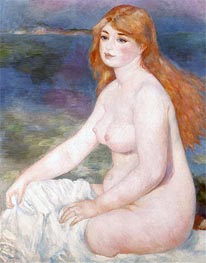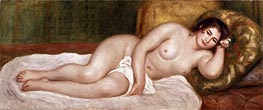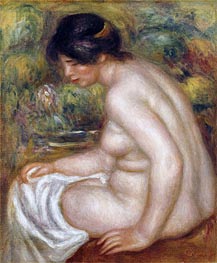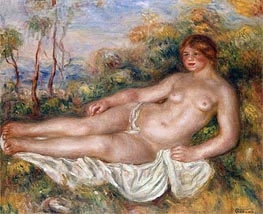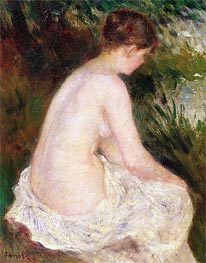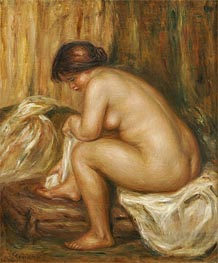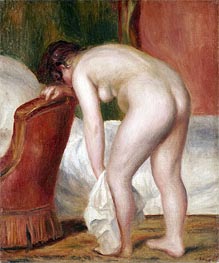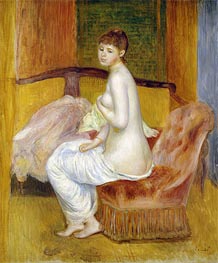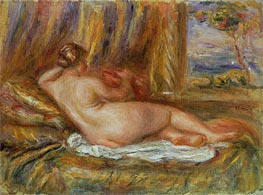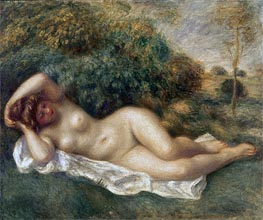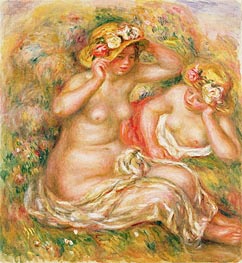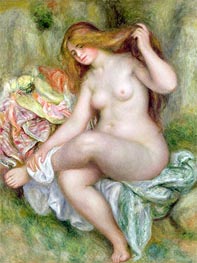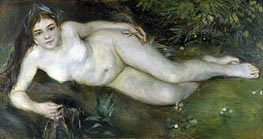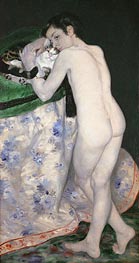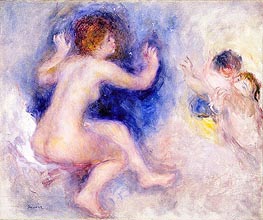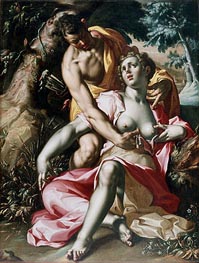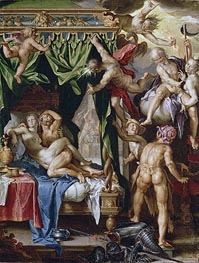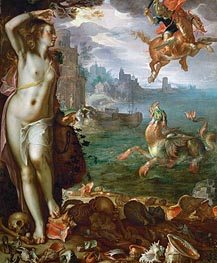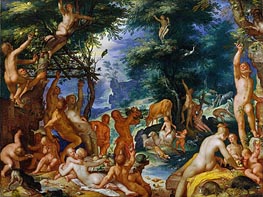Akt Painting Reproductions - Page 16
The history of nude painting can be traced back to the ancient civilizations of Greece and Rome, where the naked human form was frequently depicted in art for religious, cultural, and aesthetic purposes. During the Renaissance, artists such as Michelangelo and Botticelli continued this tradition, creating masterpieces that celebrated the beauty of the human form.
In the 19th century, the genre evolved with the advent of modernism, and many artists, such as Edouard Manet, used the naked body as a means of challenging societal norms and pushing boundaries. The 20th century saw further experimentation and exploration of the genre, with artists such as Pablo Picasso and Amedeo Modigliani incorporating elements of cubism and expressionism into their nudes.
The depiction of nudity in art has also been subject to moral, cultural, and political controversy throughout history. During the Victorian era, for example, nudity was often deemed inappropriate and was typically only depicted in a limited and idealized manner. In response, some artists sought to challenge these norms by creating more realistic and daring nudes that subverted traditional norms and expectations.
In recent years, the genre of nude painting has also become increasingly diverse, reflecting the changing attitudes and values of society. For instance, there has been a growing interest in representing the naked body in a more inclusive and diverse manner, with a greater emphasis on body positivity and representation of a wider range of body types.
Despite these changes, the genre of nude painting continues to be shaped by the cultural and political context of each era, reflecting the attitudes and values of the time. Nevertheless, the naked form remains a powerful and enduring subject for artists and art lovers alike, providing a rich and diverse canvas for exploring the human experience.
In the 19th century, the genre evolved with the advent of modernism, and many artists, such as Edouard Manet, used the naked body as a means of challenging societal norms and pushing boundaries. The 20th century saw further experimentation and exploration of the genre, with artists such as Pablo Picasso and Amedeo Modigliani incorporating elements of cubism and expressionism into their nudes.
The depiction of nudity in art has also been subject to moral, cultural, and political controversy throughout history. During the Victorian era, for example, nudity was often deemed inappropriate and was typically only depicted in a limited and idealized manner. In response, some artists sought to challenge these norms by creating more realistic and daring nudes that subverted traditional norms and expectations.
In recent years, the genre of nude painting has also become increasingly diverse, reflecting the changing attitudes and values of society. For instance, there has been a growing interest in representing the naked body in a more inclusive and diverse manner, with a greater emphasis on body positivity and representation of a wider range of body types.
Despite these changes, the genre of nude painting continues to be shaped by the cultural and political context of each era, reflecting the attitudes and values of the time. Nevertheless, the naked form remains a powerful and enduring subject for artists and art lovers alike, providing a rich and diverse canvas for exploring the human experience.
page 16 of 44
SKU: RPA-12583
Pierre-Auguste Renoir
Original Size: 90 x 63 cm
Private Collection
Pierre-Auguste Renoir
Original Size: 90 x 63 cm
Private Collection
SKU: RPA-12577
Pierre-Auguste Renoir
Original Size: unknown
Private Collection
Pierre-Auguste Renoir
Original Size: unknown
Private Collection
SKU: RPA-12566
Pierre-Auguste Renoir
Original Size: unknown
Private Collection
Pierre-Auguste Renoir
Original Size: unknown
Private Collection
SKU: RPA-12562
Pierre-Auguste Renoir
Original Size: 83 x 65 cm
Private Collection
Pierre-Auguste Renoir
Original Size: 83 x 65 cm
Private Collection
SKU: RPA-12559
Pierre-Auguste Renoir
Original Size: 55 x 80 cm
Private Collection
Pierre-Auguste Renoir
Original Size: 55 x 80 cm
Private Collection
SKU: RPA-12518
Pierre-Auguste Renoir
Original Size: 48.2 x 38.4 cm
Private Collection
Pierre-Auguste Renoir
Original Size: 48.2 x 38.4 cm
Private Collection
SKU: RPA-12517
Pierre-Auguste Renoir
Original Size: unknown
Private Collection
Pierre-Auguste Renoir
Original Size: unknown
Private Collection
SKU: RPA-12515
Pierre-Auguste Renoir
Original Size: unknown
Private Collection
Pierre-Auguste Renoir
Original Size: unknown
Private Collection
SKU: RPA-12513
Pierre-Auguste Renoir
Original Size: unknown
Private Collection
Pierre-Auguste Renoir
Original Size: unknown
Private Collection
SKU: RPA-12512
Pierre-Auguste Renoir
Original Size: 37.5 x 50 cm
Private Collection
Pierre-Auguste Renoir
Original Size: 37.5 x 50 cm
Private Collection
SKU: RPA-12511
Pierre-Auguste Renoir
Original Size: unknown
Private Collection
Pierre-Auguste Renoir
Original Size: unknown
Private Collection
SKU: RPA-12507
Pierre-Auguste Renoir
Original Size: unknown
Private Collection
Pierre-Auguste Renoir
Original Size: unknown
Private Collection
SKU: RPA-12502
Pierre-Auguste Renoir
Original Size: unknown
Private Collection
Pierre-Auguste Renoir
Original Size: unknown
Private Collection
SKU: RPA-12488
Pierre-Auguste Renoir
Original Size: 116.2 x 88.9 cm
Detroit Institute of Arts Michigan USA
Pierre-Auguste Renoir
Original Size: 116.2 x 88.9 cm
Detroit Institute of Arts Michigan USA
SKU: RPA-12480
Pierre-Auguste Renoir
Original Size: 39.4 x 29.2 cm
National Gallery London United Kingdom
Pierre-Auguste Renoir
Original Size: 39.4 x 29.2 cm
National Gallery London United Kingdom
SKU: RPA-12479
Pierre-Auguste Renoir
Original Size: 66.7 x 123 cm
National Gallery London United Kingdom
Pierre-Auguste Renoir
Original Size: 66.7 x 123 cm
National Gallery London United Kingdom
SKU: RPA-12432
Pierre-Auguste Renoir
Original Size: 123 x 66 cm
Musee d'Orsay Paris France
Pierre-Auguste Renoir
Original Size: 123 x 66 cm
Musee d'Orsay Paris France
SKU: RPA-12424
Pierre-Auguste Renoir
Original Size: 55 x 65.7 cm
The Clark Art Institute Massachusetts USA
Pierre-Auguste Renoir
Original Size: 55 x 65.7 cm
The Clark Art Institute Massachusetts USA
SKU: RPA-12419
Pierre-Auguste Renoir
Original Size: 55.9 x 46.4 cm
Philadelphia Museum of Art Pennsylvania USA
Pierre-Auguste Renoir
Original Size: 55.9 x 46.4 cm
Philadelphia Museum of Art Pennsylvania USA
SKU: RPA-12418
Pierre-Auguste Renoir
Original Size: 52.7 x 33 cm
Philadelphia Museum of Art Pennsylvania USA
Pierre-Auguste Renoir
Original Size: 52.7 x 33 cm
Philadelphia Museum of Art Pennsylvania USA
Cephalus and Procris (The Death of Procris) c.1595/00
Joachim Wtewael
Oil Painting
$5516
$5516
Canvas Print
$93.50
$93.50
SKU: WAJ-12416
Joachim Wtewael
Original Size: 129.9 x 98.4 cm
Saint Louis Art Museum Missouri USA
Joachim Wtewael
Original Size: 129.9 x 98.4 cm
Saint Louis Art Museum Missouri USA
SKU: WAJ-12415
Joachim Wtewael
Original Size: 20.3 x 15.6 cm
J. Paul Getty Museum Los Angeles USA
Joachim Wtewael
Original Size: 20.3 x 15.6 cm
J. Paul Getty Museum Los Angeles USA
SKU: WAJ-12414
Joachim Wtewael
Original Size: 180 x 150 cm
Louvre Museum Paris France
Joachim Wtewael
Original Size: 180 x 150 cm
Louvre Museum Paris France
SKU: WAJ-12413
Joachim Wtewael
Original Size: 22.5 x 30.5 cm
Metropolitan Museum of Art New York USA
Joachim Wtewael
Original Size: 22.5 x 30.5 cm
Metropolitan Museum of Art New York USA
